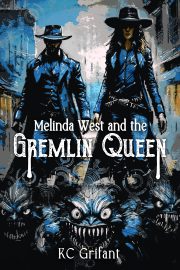Giraffes, Refrigerators, and Worldbuilding
by Kelly Swails
 A few weeks ago a friend sent me a long-winded joke complete with goofy font and cutesy pictures. It went something like this:
A few weeks ago a friend sent me a long-winded joke complete with goofy font and cutesy pictures. It went something like this:
Q: How do you put a giraffe in a refrigerator?
A: Open the door, put in the giraffe, and close the door.
Q: How do you put an elephant into a refrigerator?
A: Open the door, take out the giraffe, put in the elephant and close the door.
Q: The Lion King is hosting and animal conference. All the animals attend … except one. Which animal misses the conference?
A: The elephant. He’s in the refrigerator.
Q: there is a river you must cross but it is used by crocodiles and you don’t have a boat. How do you manage it?
A: You jump into the river and swim across. All the crocodiles are at the Animal Conference.
After I groaned, I chided myself for not seeing it coming. Why? Because this is a lesson in worldbuilding dressed as a joke.
Building a unique world for characters to live in is complex, even more so when an author is writing fantasy and science fiction. An author must juggle hundreds of details and facts, only a fraction of which may end up in the final manuscript. Those details include—but are certainly not limited to—dates of historical events, geography, languages, government, economics and currency, and dietary habits of imaginary or long-forgotten tribes. It’s the author’s job to give the world enough depth and nuance that readers will suspend their disbelief. But a thousand years of back-story or a genealogy of the protagonist’s sex partners won’t do a bit of good if story details change in midstream. If Sally’s favorite ice cream is peppermint in chapter two but chocolate in chapter twenty–the reader can be jolted out of the story. Writers have to remember to take the giraffe out of the refrigerator so they can put the elephant in.
While a few writers may be able to keep everything straight in their head, the rest of us need organizational tools. Some systems are better than others, but the most perfect system in the world for another writer will fail if it doesn’t click with your own work style.
Old School
Grab a spiral notebook and fill it with notes about your world and the people in it. Collect pictures of people, places, and things. Hear a snippet of dialogue at the coffee shop that your secondary would say? Add it to the notebook. By the time your novel is finished, your notebook will be part time capsule, part bible, and part journal. If this is too haphazard for you, add a detailed outline of your world. Want to format it with roman numerals and letters and numbers? Sure. Want to write your whole novel longhand? Go ahead. No one’s looking.
Build A Wall
Pull out your tool belt, roll up your sleeves, and do a little home improvement. Buy a 4’x8′ panel of white laminate and mount it on your office wall. Presto! You’ve got yourself a massive whiteboard for a fraction of the price. Use the money you saved to buy dry erase makers and go crazy. Give each character their own color. Draw a detailed map. Use one corner for a word-count meter.
Feel like you want something a bit more permanent? Apply chalkboard paint to one wall of your office. Have a magnet fetish? Paint a big piece of metal or coat a wall with magnetic primer and top coat it with the chalkboard paint. Do-it-yourselfers unite!
Technology Is Your Friend
Sure, you can use your phone to snap pictures of interesting buildings or people or plants that inspire you. But why not go one step further? Make Facebook accounts for your characters and fill out all the personal information. Take a dozen quizzes as your character to really get into their heads. Have fun with interpersonal dynamics by having them post on one another’s walls. (This would be especially fun after your novel is published and you let your new fans in on the fun.) And look . . . now you’ve got a virtual history of your characters!
I’m calling a truce on the “Apple vs. Microsoft” debate because both sides have great products for writers. Microsoft Office has the trusty (yet admittedly utilitarian) Excel and Word software. For the Mac users out there, give iWork or Bento a look.
If you’re interested in a third party solution and have a Mac, be sure to check out Scrivener. For PC and Linux users, beta versions are available. All have a free 30 day trail.
Looking for a little more interaction? If you’ve got a bonus check burning a hole in your pocket, you can buy an iPad, or, if you’ve won the lottery, invest in Microsoft Surface for your next desk.
As with everything in writing, there are no right or wrong answers. Whatever gets your butt in the chair and a cohesive, finished novel out the door is the method you should use. Want to use the same method all the time, or five different systems for the same book? Have at it. It’s your world; build it the way you want. Readers don’t care how you keep track of everything. They just want to be sure you remember the crocodiles are at the Animal Conference so you can get their beloved characters across the river in one piece.
•••
Kelly Swails has been getting paid to tell lies since 2006. Her work has appeared in numerous anthologies from DAW and Walkabout Publishing. When she’s not writing or working her day job, she reads, knits, and watches geeky movies. There’s an internet rumor she sleeps occasionally, but that has yet to be proven. You can find her online at her website, read her blather about writing and life on her blog, and follow her on twitter.


